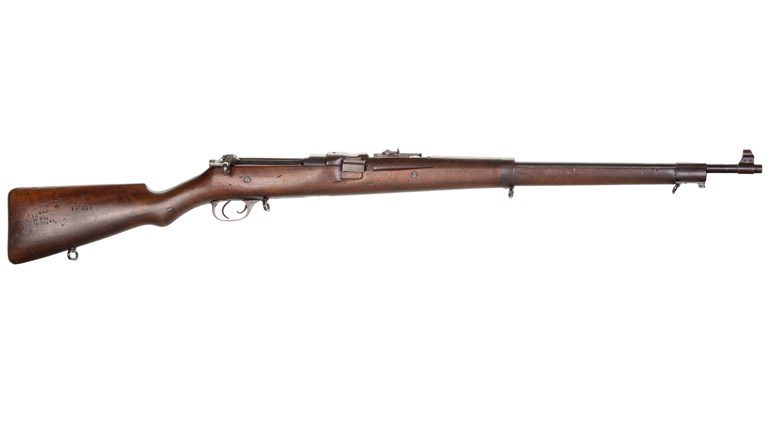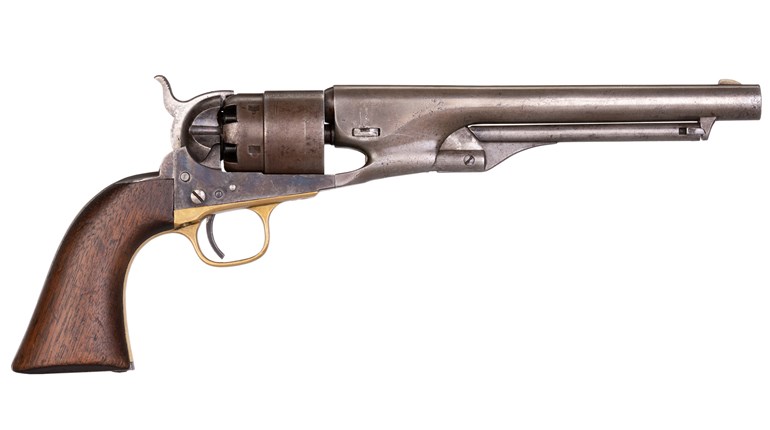
While the fine lines, elegant tripod and attached leather case might give the appearance of a fine instrument, the Colt Model 1895 Automatic belt-fed machine gun brought the full brutality of modern warfare to the start of the 20th century • This particular model, S/N 161, can be traced directly to Soldiers fighting with Theodore Roosevelt’s “Rough Riders.”
This is the story of a potato digger, more accurately a Model 1895 Browning belt-fed, air-cooled machine gun manufactured by Colt. Designed by the creative genius of John M. Browning, the Model 1895 was the first American machine gun ever manufactured. It received its nickname, “potato digger,” from the fact that the operating lever used to cycle the working mechanism flopped downward after every shot, and if the gun was placed too close to the ground, it would strike small divots into the earth resembling spud holes.
As fate would have it, two of these new wonder weapons would find their way into the use of the 1st U.S. Volunteer Cavalry, aka Roosevelt’s Rough Riders, during their campaign in Cuba in June and July, 1898. In May of 1898, LTC Theodore Roosevelt assembled nearly 1,000 New York polo players, Harvard and Princeton men, and assimilated them with Texas, New Mexico and Arizona toughs, cowboys, lawmen and even some outlaws into a fighting unit with such esprit de corps that they were the envy of the entire Army.
Roosevelt saw to it that his men were the best equipped soldiers on the field, and he made sure that they were armed with the Model 1896 Krag-Jørgensen carbines that fired the new smokeless .30-40 cartridge. While not exactly superior to the Spanish7 mm, the .30-40 Krag was still a vast improvement over the .45-70 Gov’t. blackpowder round in use throughout the Army. In his 1899 book, “The Rough Riders,” Roosevelt wrote, “Our regiment had accumulated two rapid-fire Colt automatic guns, the gift of Stevens, Kane, Tiffany and one or two others of the New York men, and also a dynamite gun, under the immediate charge of Sergeant Borrowe.”
Roosevelt soon assigned SGTs Borrowe and Tiffany to a Gatling gun detachment commanded by 1LT John H. Parker, who had four Gatling Guns also chambered in .30-40 Krag. Of the battle for San Juan Hill on July 1, 1898, Roosevelt wrote:

“Suddenly, above the cracking of the carbines, rose a peculiar drumming sound, and some of the men cried, “The Spanish machine-guns!” Listening, I made out that it came from the flat ground to the left, and jumped to my feet, smiting my hand on my thigh, and shouting aloud with exultation, “It’s the Gatlings, men, our Gatlings!” Lieutenant Parker was bringing his four gatlings into action, and shoving them nearer and nearer the front. Now and then the drumming ceased for a moment; then it would resound again, always closer to San Juan hill, which Parker, like ourselves, was hammering to assist the infantry attack. Our men cheered lustily. We saw much of Parker after that, and there was never a more welcome sound than his Gatlings as they opened. It was the only sound which I ever heard my men cheer in battle.”
In actuality, there were two Spanish Maxims at San Juan Hill, but they were not employed to their best advantage as they made no impact on the outcome of events. Roosevelt’s potato diggers, however, supported the charge up Kettle Hill and then San Juan Hill, nearly expending all 4,000 rounds of the 7 mm with which the guns came equipped. Luckily for the members of the 1st USV MG Detachment, the Spanish Model 1893 Mausers were also chambered in
7 mm and there was plenty of captured ammo to fully stock both guns for the rest of the campaign.
As the U.S. Army laid siege to Santiago following the successful attack upon San Juan Hill, Roosevelt’s Rough Riders settled in for a long campaign in the trenches. Roosevelt wrote: “Parker had taken two of his Gatlings, removed the wheels, and mounted them in the trenches; also mounting the two automatic Colts where he deemed they could do best service.” More than once Roosevelt saw Parker and Tiffany rake the tree tops with the Gatlings and potato diggers to rid them of Spanish snipers.
One last push by the Spanish to lift the siege was made on July 10, and Roosevelt wrote that Parker and Tiffany played a key part in silencing the Spanish artillery, taking any punch out of their ill-fated attack. Seven days later, the Spanish surrendered.
And what became of the hardware used by 1LT Parker’s detachment? The fate of three of the four Gatling guns is well known: One is in the National Firearms Museum, a gift of the Robert E. Petersen Foundation, and two others are in private collections. As for the two Model 1895 potato diggers, nothing was known of their fate for 114 years after their glorious debut as the first machine guns ever employed in combat by the United States Army.
The few clues we have on them are that they were purchased by “Stevens, Kane, Tiffany, and one or two others … ” and Dolph Goldsmith identified them as serial numbers 161 and 164 sold by the American Ordinance Company of New York City, NY, in May of 1898 and shipped to San Antonio, TX, for use by the Rough Riders. Other than that, the trail goes exceedingly cold.
*Apologies to 1LT John H. Parker’s “The Gatlings at Santiago,” 1898.

That is until the fall of 2012, when I was fortunate to pay a visit to the Theodore Roosevelt Birthplace National Historic Site in lower Manhattan. The occasion was an exhibit of the trappings of the 1912 Bull Moose Presidential campaign that almost put Theodore Roosevelt back in the White House after a four-year absence. On my way out of the house, I noticed a potato digger in the basement, chained to a steam radiator. Initially described to me as a Gatling gun, I politely suggested that it was actually a potato digger. I pulled out my handy SureFire flashlight and illuminated the gun, searching for its serial number.
As a museum curator, I never expected to have a “Howard Carter” (of King Tut’s tomb) moment of discovery in my career but as the light traced its way along the receiver of the Model 1895, the serial number 161 became illuminated. The SureFire also illuminated an engraved inscription that had eluded everyone else who had seen it in the past 114 years: “Presented to the 1st U.S.V. Cavalry (Rough Riders) By L. and S. Kane Las Guasimas June 24th San Juan July 1st Santiago (Siege of) 1898.” Here we found another puzzle piece to the Rough Riders potato digger. It had been gifted by Louisa Langdon Kane and her sister Sybil Kent Kane, the older sisters of CPT Woodbury Kane, of K Troop of the Rough Riders. So, the first machine gun ever used by the U.S. Army in combat was a gift from two sisters to their little brother to take to Cuba. Today, it is proudly on loan from the National Park Service to the National Firearms Museum in Fairfax, VA, and displayed next to Gatling Model 1895 S/N 1040.
*Apologies to 1LT John H. Parker’s “The Gatlings at Santiago,” 1898.





































